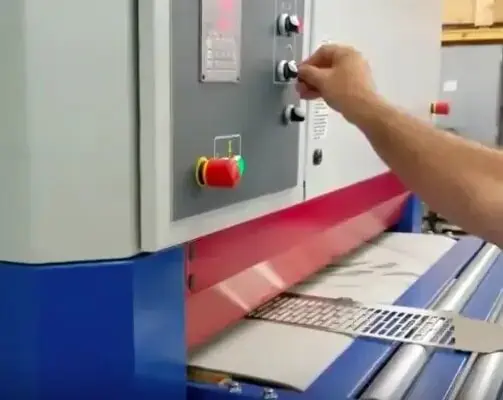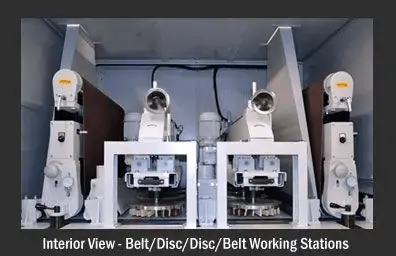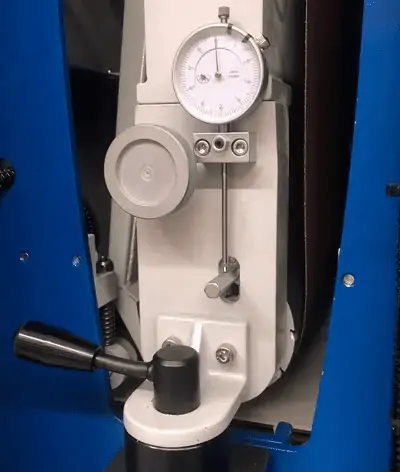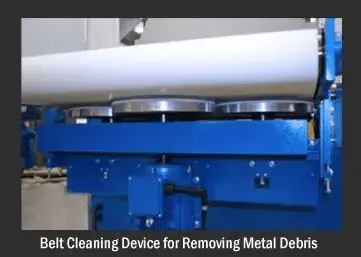Whether your shop is machine cutting with a laser, flame, or plasma table, the process of manually deburring flat metal parts is very similar. The cutting machine operator unloads cut parts, places another sheet onto the table, and activates the machine. While the machine is cutting the new sheet, the table operator manually grinds any burrs or slag off the edges of newly cut parts. As the operator finishes grinding parts, the cutting table has completed its next operation. The grinded parts are then taken downstream by a material handler and the operator repeats the process by unloading and loading the cutting table with another metal sheet or heavy plate.
The Problem with Deburring Metal by Hand
This may sound like the perfect process for low-volume metal fabricators, but problems tend to arise due to the natural variability within machine shops. With some geometries taking longer than others, operator grinding fatigue, and skill variation between operators, it is next to impossible to maintain a consistent and efficient manual grinding and deburring process. This problem is only magnified when the finished appearance of the part is also important. These are only a handful of the numerous issues metal fabricators face that lead to decreased quality, reduced consistency and bottlenecks when manually grinding parts as part of the sheet or plate cutting operations.
Benefits of Automated Deburring
In an automated deburring process, a single deburring machine can usually handle numerous cutting tables, with as few as one operator for the deburring machine and one for the cutting tables. With an automated deburring machine integrated into the cutting process, parts can be cut, deburred, finished and sent to their downstream processes immediately. This ultimately reduces bottlenecks, materials/labor cost and part variability while increasing efficiency and consistency at the same time.
This seems like a win-win situation for any job shop doing metal fabrication, right?
Finding the Right Automated Deburring Machine
Determining the right automated deburring solution is a time-intensive process which requires a comprehensive look at the specific application requirements a shop has. Differences in part size, thickness, profile, tolerance, material grades and the required finish will all play a major role in identifying and integrating an automated deburring solution. When all of these factors are examined and a corresponding machine is configured properly, the shop can then experience the many benefits that an automated deburring solution has in store for them.
It may seem that deburring flat parts with a machine is a simple process of just putting the part into a single-head machine and having it come out finished and free of burrs, but it is often more complex than that. A single-head deburring machine using a grinding belt will help remove vertical burrs, but often rolls the burrs over, creating a horizontal burr. Parts coming out with horizontal burrs can be a hazard to operators and material handlers—they can easily cut themselves on the sharp horizontal burrs now leading and trailing the part.
The primary solution to this problem is a multi-head machine that contains an abrasive barrel or discs containing abrasive brushes, pictured to the right is our 2052M-DSSDc machine. Disc brushes will oscillate across the parts surface, while a barrel brush is fixed horizontally and rotates opposite the belt feed. By combining disc or barrel brushes with an abrasive wide-belt head, the sharp edges created by cutting off the vertical burrs can be softened and easily removed. This combination of working heads can achieve a burr-free part that is also safe to handle. At Apex, we have team of experienced application specialists, which help customer’s to determine the correct head configuration for their specific application requirements.
Drum Hardness
Application requirements (material type, thickness, profile, required finish, etc.) will help determine the proper hardness rating for any specific application. Also known as durometer, the hardness rating measures how hard the contact drum, brush or barrel media is. For example, a wide-belt abrasive head with a softer contact drum (~40 durometer) will put a larger radius on part edges, while a much harder contact drum (~80 durometer) would be used for heavy grinding without edge radiusing.
Stock Removal
To determine the amount of stock removed by a single pass, one must consider machine feed speed, motor horsepower, drum hardness, and the type of abrasive media used. Using the previous example, an 80 durometer contact drum with a coarse grit abrasive belt will remove significantly more material from a part than disc brushes using a less aggressive grit, although abrasive brushes will radius part edges much more than the harder contact drum with an abrasive belt will.
Grit Size
Grit size plays a central role in creating grained finishes. Coarse grits are typically used to remove material, while finer grits are used to achieve a desired finish. A three head belt machine would likely first use an 80 grit belt to remove some stock, followed by a 120 grit belt to apply a finer grain finish, and finally a 150 grit belt to apply a #4 or #5 finish before the part exits the machine.
Securing Your Workpiece
How a part will be held while feeding through the machine is important to consider, too. This will determine the type of abrasive heads and conveyor belt that are to be used. If a part is too small to be held by pinch rollers, then part slippage will occur. Part slippage can cause an undesired finish, incomplete deburring, and even damage the machine’s components if the part is being thrown by the abrasive head. To avoid part slippage, confirm that the work-piece is equal in length to the distance between each pinch roller. This ensures that at least one pinch roller is securing the part while it is being processed by the abrasive head.
Sometimes, manufacturers keep a group of tabbed parts attached to their skeleton, processing the entire sheet. This can create burrs and marks when breaking the tabs to remove the parts, which might require further processing. Fixtures can also be created for firmly securing parts to the conveyor bed, but these are designed specifically for each part or family of parts. If a part is too small to be secured by pinch rollers, there are additional bed options to look into for securing parts.
Some customers decide on using a vacuum bed, incorporating a blower that pulls air through small holes in the belt and securing parts by suction. If the part is magnetic, a magnetic chuck can also be installed to hold the parts in place. A conveyor bed with a “sticky belt”, can secure parts through their processing due to the added traction, but generally requires a belt cleaning device to remove dust and material that cause the belt to lose its adhesion onto parts over time.
After considering application requirements, finding the right machine and integrating it properly, automated deburring is a simple and cost-effective process. Generally the only setup required will be changing the bed height to match part thickness. This process is as simple as typing the part thickness into the control panel; lifting or lowering the conveyor bed in seconds. Sometimes a change of abrasive belts for a different finish may be required, this typically takes no more than 5 minutes. Occasionally the disc or barrel brush media needs to be changed out, which can take less than an hour.
Ready to Automate Your Metal Deburring Process?
Integrating an automated deburring system can turn a somewhat inconsistent manual process into a much more consistent, efficient and reliable one. Assessing application requirements to determine proper machine configuration is the most intensive part of integrating an automated deburring solution and generally requires some trial runs to fine tune. Once the machine is properly in place, it can seem like it’s not even there.
At Apex, we’re dedicated to seeing you through the integration process. No matter where you’re at with automating your metal deburring, we want to help. Reach out today to learn more about how we can work with you to identify the right metal finishing solution for your needs.



